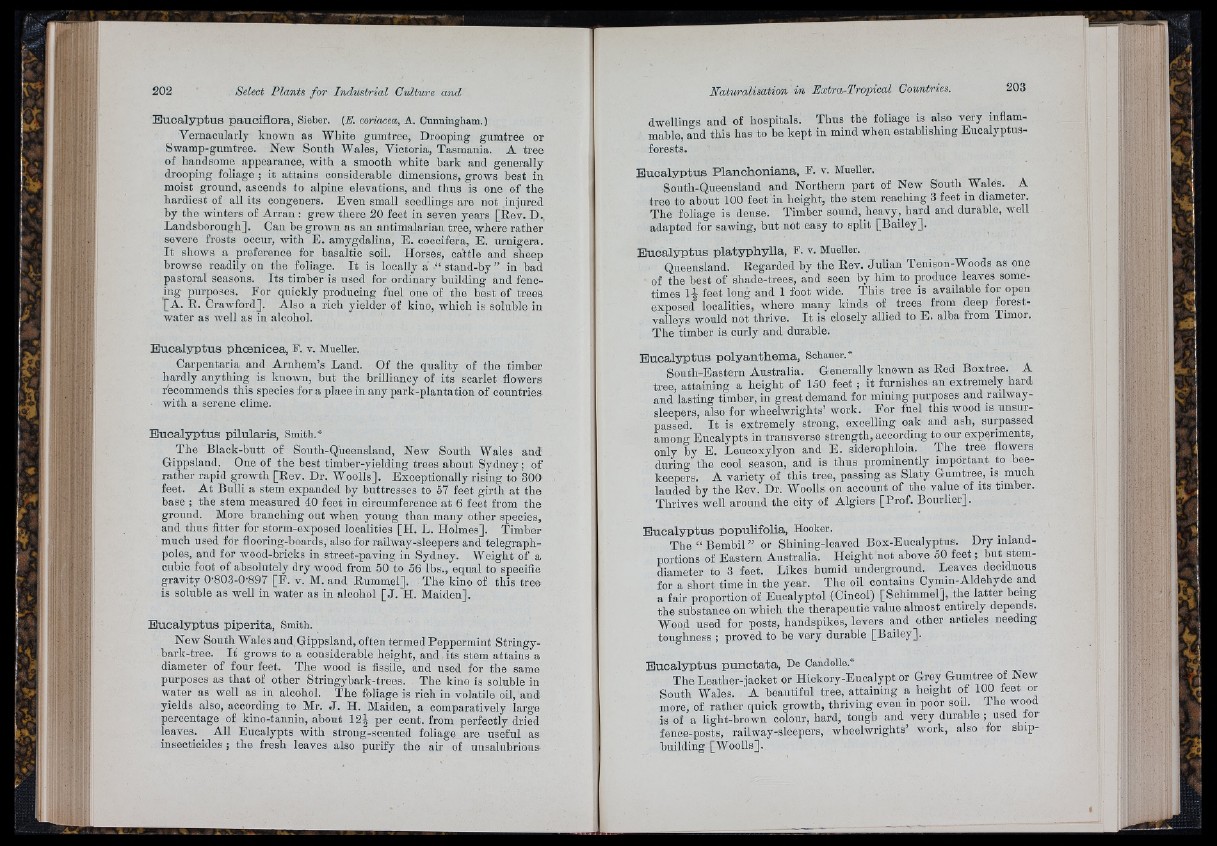
U | l
ft ■'
f I ®
r S liifr
i t i l :
■Ï
I I
. I f r i.
!:: 'nY-jA
I; i tT
I- \ j t i
I r #
'Ml
Eucalyptus pauciflora, Sieber. (E. coriacea, A. Cunningham.)
Vernacularly known as White gumtree, Drooping gumtree or
Swamp-gumtree. New South Wales, Victoria, Tasmania. A tree
of handsome appearance, with a smooth white hark and generally
drooping foliage ; it attains considerable dimensions, grows best in
moist ground, ascends to alpine elevations, and thus is one of the
hardiest of all its congeners. Even small seedlings are not injured
by the winters of Arran : grew there 20 feet in seven years [Eev. D.
Landsborough]. Can be grown as an antimalarian tree, where rather
severe frosts occur, with E . amygdalina, E. coccifera, E. urnigera.
I t shows a preference for basaltic soil. Horses, cattle and sheep
browse readily on the foliage. I t is locally a “ stand-by ” in had
pastoral seasons. Its timber is used for ordinary building and fencing
purposes. For quickly producing fuel one of the best of trees
[A. R. Crawford]. Also a rich yielder of kino, which is soluble in
water as well as in alcohol.
Eucalyptus phcenicea, F. v. Mueller.
Carpentaria and Arnhem’s Land. Of the quality of the timber
hardly anything is known, but the brilliancy of its scarlet flowers
recommends this species fo ra place in any park-plantation of countries
with a serene clime.
Eucalyptus pilularis, Smith.*
The Biack-butt of South-Queensland, New South Wales and
Gippsland. One of the best timber-yielding trees about Sydney; of
rather rapid growth [Rev. Dr. Woolls]. Exceptionally rising to 300
feet. A t Bulli a stem expanded by buttresses to 57 feet girth at the
base ; the stem measured 40 feet in circumference a t 6 feet from the
ground. More branching out when young than many other species,
and thus fitter for storm-exposed localities [II. L. Holmes]. Timber
much used for flooring-boards, also for railway-sleepers and telegraph-
poles, and for wood-bricks in street-paving in Sydney. Weight of a
cubic foot of absolutely dry wood from 50"to 56 lbs., equal to specific
gravity 0'803-0'897 [F . v. M. and Rummel]. The kino of this tree
is soluble as well in water as in alcohol [ J . H. Maiden].
Eucalyptus piperita, Smith.
New South Wales and Gippsland, often termed Peppermint Stringybark
tree. I t grows to a considerable height, and its stem attains a
diameter of four feet. The wood is fissile, and used for the same
purposes as th a t of other Stringybark-trees. The kino is soluble in
water as well as in alcohol. The foliage is rich in volatile oil, and
yields also, according to Mr. J . H. Maiden, a comparatively large
percentage of kino-tannin, about 121 per cent, from perfectly dried
leaves. ^ All Eucalypts with strong-scented foliage are useful as
insecticides ; the fresh leaves also purify the air of unsalnbrious
dwellings and of hospitals. Thus the foliage is also very inflammable,
and tbis has to be kept in mind when establishing Eucalyptus-
forests.
E u c a ly p tu s P la n c h o n ia n a , F. v. Mueller.
South-Queensland and Northern part of New South Wales. A
tree to about 100 feet iu height, the stem reaching 3 feet in diameter.
The foliage is dense. Timber sound, heavy, hard and durable, well
adapted for sawing, but not easy to split [Bailey].
E u c a ly p tu s p la ty p h y lla , F. v. Mueller.
Queensland. Regarded by the Rev. Julian Tenison-Woods as one
of the best of shade-trees, and seen by him to produce leaves sometimes
11 feet long and 1 foot wide. This tree is available for open
exposed localities, where many kinds of trees from deep forest-
valleys would not thrive. I t is closely allied to E. alba from Timor.
The timber is curly and durable.
E u c a ly p tu s p o ly a n th em a , Sohauer.*
South-Eastern Australia. Generally known as Red Boxtree. A
tree, attaining a height of 150 feet ; it furnishes an extremely hard
and lasting timber, in great demand for mining purposes aud railway-
sleepers, also for wheelwrights’ work. For fuel this wood is unsurpassed.
I t is extremely strong, excelling oak and ash, surpassed
among Eucalypts in transverse strength, according to our experiments,
only by E. Leucoxylyon and E . siderophloia. The tree flowers
during the cool season, and is thus prominently important to beekeepers.
A variety of this tree, passing as Slaty Gumtree, is much
lauded by the Rev. Dr. Woolls on account of the value of its timber.
Thrives well around the city of Algiers [Prof. Bourlier].
E u c a ly p tu s p o p u lifo lia , Hooker.
The “ Bembil ” or Shining-leaved Box-Eucalyptus. Dry mland-
portions of Eastern Australia. Height not above 60 feet ; but stem-
diameter to 3 feet. Likes humid underground. |e a ^ e s deciduous
for a short time in the year. The oil contains Cyrnin-Aldehyde and
a fair proportion of Eucalyptol (Cineol) [Schimmel], the latter being
the substance on which the therapeutic value almost entirely depends.
Wood used for posts, handspikes, levers and other articles needing
toughness ; proved to he very durable [Bailey].
E u c a ly p tu s p u n c ta ta , De Candolle.*
The Leather-jacket or Hickory-Euoalypt or Grey Gumtree of New
South Wales. A beautiful tree, attaining a height of 100 teet or
more, of rather quick growth, thriving even in poor soil. The wood
is of a light-brown colour, hard, tough and very durable ; used tor
fence-posts, railway-sleepers, wheelwrights’ work, also for shipbuilding
[Woolls].